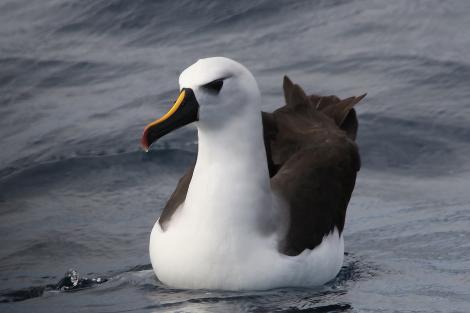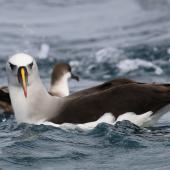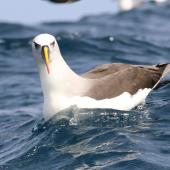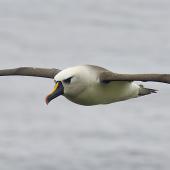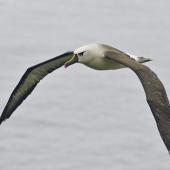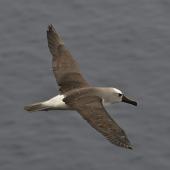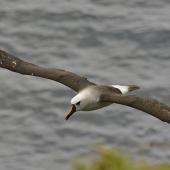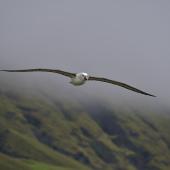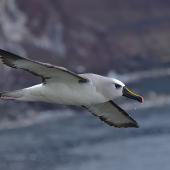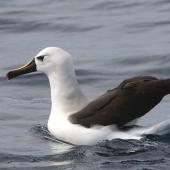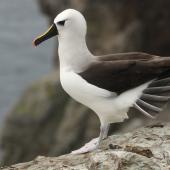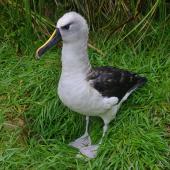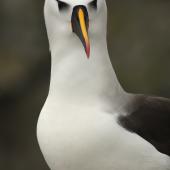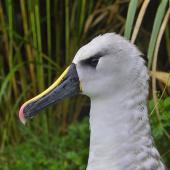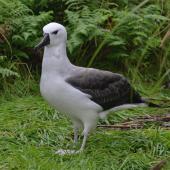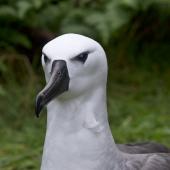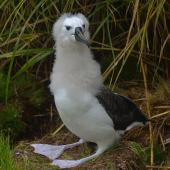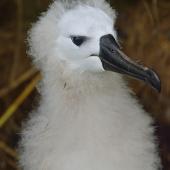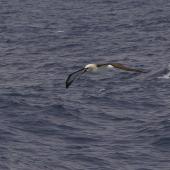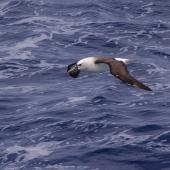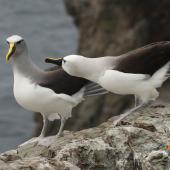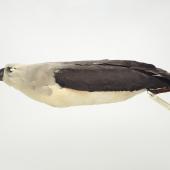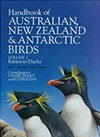Atlantic yellow-nosed mollymawk
Thalassarche chlororhynchos (Gmelin, 1789)
Order: Procellariiformes
Family: Diomedeidae
Other names: Atlantic yellow-nosed albatross, yellow-nosed mollymawk, western yellow-nosed albatross, western yellow-nosed mollymawk, yellow-nosed albatross, yellow nosed mollymawk, yellownosed mollymawk, yellow nosed albatross, yellownosed albatross
Geographical variation: The closely related Indian Ocean yellow-nosed mollymawk (T. carteri) is sometimes regarded as conspecific.
The Atlantic yellow-nosed mollymawk is one of the smallest and slightest in build of the albatross family. It has a distinctive pale grey head, pale forehead and prominent black eye-patch in front of eye; yellow culmen stripe on upper mandible and rose-pink nail. It breeds on islands in the South Atlantic, and is a rare vagrant to New Zealand waters. The Atlantic yellow-nosed mollymawk may be confused at sea with the closely-related Indian Ocean yellow-nosed albatross which is an irregular visitor to New Zealand coastal waters.
Identification
The Atlantic yellow-nosed mollymawk is a small albatross that breeds in the South Atlantic Ocean on Gough Island and islands in the Tristan da Cunha group. The forehead is white, with a hooded effect created by a pale grey wash on the cheeks and nape. There is a prominent triangular black patch in front of eyes reaching almost to the base of the bill, and a narrow white crescent behind the eye. The upperwing, mantle and tail are greyish-black, and the body and rump are white. The underwing is white with narrow black margins, widest at the front, and a black wing tip. The bill is (for an albatross) long and slender, and is black with a narrow chrome yellow culmen stripe, becoming cherry pinkish at the nail. The base of the culmen is broad and rounded, and surrounded by bare black skin, with the central yellow stripe not reaching the feathers.
Voice: usually silent at sea except for a braying cackle if competing for food in a group.
Similar species: the similarly-sized Indian yellow-nosed albatross, is mainly white-headed and without a prominent triangular eye-patch. The base of the yellow culmen stripe is sharply pointed (cf. broader and round-ended in Atlantic yellow-nosed mollymawk). Buller’s mollymawks have a similar underwing pattern, but are slightly bulkier, darker grey on the sides of the head, and have a black bill with chrome yellow along the bottom of the lower mandible as well as on the culmen.
Distribution and habitat
The Atlantic yellow-nosed mollymawks breed in loose colonies at Gough and the Tristan da Cunha Islands (including Nightingale and Inaccessible Islands) in the South Atlantic Ocean. They disperse throughout the South Atlantic (mainly from 10-45° S) and eastwards into the Southern Indian Ocean with stragglers regularly reaching eastern Australia, and occasionally New Zealand.
New Zealand records
The first three New Zealand records were all from Little Sister Island, Chatham Islands, close to colonies of northern Buller’s mollymawks and northern royal albatrosses. The first was seen in January 1975, and possibly same bird was collected for the Museum of New Zealand during September 1976, when dissection indicated the recent laying of an egg. A further individual was sighted ashore there in mid-January 1996, one off Kaikoura in March 2016, one on the Forty Fours, Chatham Islands, in December 2016, and one off the Snares Islands in November 2019.
Breeding
Laying September – October at breeding islands in the South Atlantic. Breeding as for other albatrosses, with long-term monogamous pairing, and obligate shared care of the single egg and resulting chick, which fledges in late March through to May.
Behaviour and ecology
The individuals ashore on the Little Sister Island walked with a hunched posture and low profile, unlike the upright walking posture of the local northern Buller’s mollymawks.
Food
The Atlantic yellow-nosed mollymawk is a surface feeder known to feed on squid, fish and crustaceans.
Websites
References
Brooke, M. 2004. Albatrosses and petrels across the world. Oxford University Press.
Checklist Committee (OSNZ). 2022. Checklist of the Birds of New Zealand (Fifth edition). Ornithological Society of New Zealand Occasional Publication No. 1. Wellington, Ornithological Society of New Zealand.
De Roy, T.; Jones, M.; Fitter, J. 2008. Albatross: their world, their ways. David Bateman Ltd,Auckland.
Marchant, S.; Higgins, P.J. (eds) 1990. Handbook of Australian, New Zealand and Antarctic birds. Vol.1, ratites to ducks. Oxford University Press, Melbourne.
Miskelly, C.M.; Crossland, A.C.; Sagar, P.M.; Saville, I.; Tennyson, A.J.D.; Bell, E.A. 2017. Vagrant and extra-limital records accepted by the Birds New Zealand Records Appraisal Committee 2015-2016. Notornis 64: 57-67.
Onley, D.; Scofield, P. 2007. Albatrosses, petrels and shearwaters of the world. Christopher Helm, London.
Robertson, C.J.R. 1975. Yellow-nosed mollymawk (Diomedea chlororhynchus) recorded in the Chatham Islands. Notornis 22: 342-344.
Robertson, C.J.R. 1996. From the President’s desk. OSNZ News 78: 3.
Robertson, C.J.R. 2002. The scientific name of the Indian yellow-nosed albatross Thalassarche carteri. Marine Ornithology 30: 48-49.
Tickell, W.L.N. 2000. Albatross. Pica Press, Sussex, UK.
Recommended citation
Robertson, C.J.R. 2013 [updated 2022]. Atlantic yellow-nosed mollymawk. In Miskelly, C.M. (ed.) New Zealand Birds Online. www.nzbirdsonline.org.nz
Atlantic yellow-nosed mollymawk
- Breeding season
-
- Jul
- Aug
- Sep
- Oct
- Nov
- Dec
- Jan
- Feb
- Mar
- Apr
- May
- Jun
- Egg laying dates
-
- Jul
- Aug
- Sep
- Oct
- Nov
- Dec
- Jan
- Feb
- Mar
- Apr
- May
- Jun




